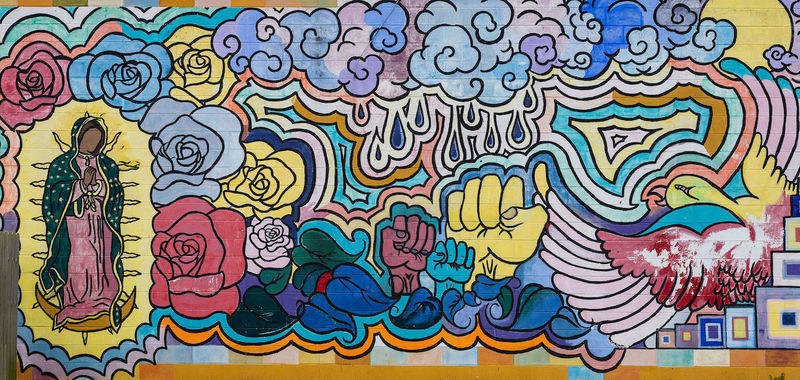 Photo by Barbara Johnston
Photo by Barbara Johnston
It started over lunch. On a Wednesday afternoon in December 2015, a few organizers had invited anyone who’d come to Taqueria Chicago, a cozy Mexican restaurant in a yellow-painted brick building on South Bend’s west side. Owner Maria Arellano had been running the eatery on Western Avenue for more than two decades, and its neighborhood had just received a makeover from the city: expanded sidewalks, repaved streets, new streetlamps and trees.
All that was great, “but it’s not just concrete that’s going to invite people to come visit,” notes Sam Centellas, the executive director of La Casa de Amistad community center and a co-founder of the lunch club. “So we said, ‘Look, let’s invite people to come out for lunch. No agenda, no cost, besides the cost of your lunch.’” To organizers’ delight, about 30 people showed up and squeezed into booths to eat tacos and chat — the kitchens could hardly keep up.
West Side Wednesdays became a monthly practice, and its organizers, now known as West Side South Bend, opened a community center on Western Avenue in 2018.
Today the group celebrates the multicultural heritage and businesses of the west side, especially the Latino community that lives and works along Western Avenue. They also hope to change minds: A low-income community, the west side has been maligned and overlooked by city residents and Notre Dame students alike.
Leading the public relations charge is Christin Kloski, a project coordinator in Notre Dame’s Office of Student Enrichment and event planner for West Side South Bend. Kloski has strong ties to the west side: Her mother, who’s Mexican, and her father, who’s Polish, both grew up here, so she feels connected to the immigrant communities that have shaped the west side for years. “It just connects full circle,” she says.
Here are a few recommendations from west side organizers and others on how to get the most out of your visit to the shops and restaurants along Western Avenue.
Learn local history, go to Mass — or both.
Walking into St. Adalbert Catholic Church, you’ll get a sense for the history of this part of the west side. Polish immigrants, who founded the neighborhood in the late 19th century, built the church in 1926. Beneath the Gothic arches — painted a cool light blue — you’ll see a mural depicting Polish immigrants laboring in fields, with smoke billowing out of factories in the background. An inscription above a depiction of Jesus reads, “By the sweat of your brow you have received the bread of life.”
During and after South Bend’s industrial collapse, a new wave of immigrants settled in. Mexican migrant farmworkers began to arrive in the 1940s, and Latino immigration into the area increased in the 1960s and ’70s — that’s when La Casa de Amistad was founded, in 1973. Now at St. Adalbert, Rev. Paul Ybarra, CSC, ’02, ’04M.Ed., ’10M.Div. celebrates Mass in Spanish and English and ministers to more than 800 Latino families.
Eat a delicious meal . . .
Google “best tacos in South Bend” and you’ll discover a competition that starts on the eastern end with Flamingo’s Mexican Restaurant & Grocery downtown. Nobody can agree on a winner, but most concur that Western Avenue boasts some of the best restaurants
in town, period. Drop by Rosales Super Market for authentic Mexican groceries and tacos in its adjoining restaurant, or visit Taqueria Chicago or Taqueria El Aguila, two other
beloved taco joints. Chico’s Mexican and American Restaurant serves Tex-Mex fare, and
El Tecate serves seafood dishes, such as ceviche and shrimp tacos.
. . . and spring for dessert.
La Rosita’s hot pink awning stands out on the block, and so do its ice creams. Juan and Rosalina Cervera have run the paletería since 2002 and make everything in-house. Try every flavor of creamy paletas — Mexican popsicles — and their signature chamoyada: shaved ice, mango, strawberry and pineapple chunks mixed with sorbets and spiced with chamoy and Tajín. And if you visit La Central Panadería around 9:30 a.m., Sam Centellas says, you’ll likely encounter the sights and lovely smells of Andres Cervantes making his signature conchas, Mexican sweet breads, for about 50 cents apiece.
Explore public art.
West side organizers often lead walking tours, which gives visitors ample opportunity to admire the murals painted on buildings throughout the neighborhood. Federico “Chico” Rodriguez commissioned his own likeness in a sprawling, Wild West-themed mural on Chico’s restaurant, an homage to his Texas roots. Taqueria Chicago’s name appears in bold, graffiti-style letters against the Chicago skyline; at Rosales Super Market, a colorful Virgen de Guadalupe appears next to three hands raised in solidarity. “I like to show [these murals] because people don’t think about beautiful icons and gems in a neighborhood that people would traditionally avoid,” Centellas says.
Attend a summer festival.
In 2016, West Side South Bend decided to add an annual summer block party to their roster of events. “We just thought, ‘Sure, why not. Let’s just do something, and hope for the best,’” Kloski says. Since they started hosting festivals, attendance has always surpassed — in some cases, doubled — expectations. Last year, the neighborhood’s observance of Best. Week. Ever., a citywide festival, drew more than 2,000 people and dozens of vendors. “Even in 2018 — it was a very rainy day. But still, over a thousand people came through,” Kloski says. “We had music, we had vendors. We had salsa dancing in the rain.”
Nora McGreevy is a South Bend freelance writer whose work has appeared in The Boston Globe and Washingtonian magazine